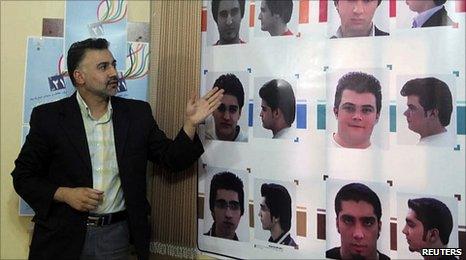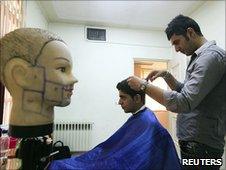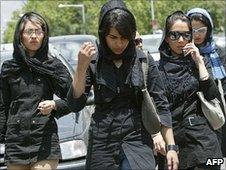Iran cracks down on 'decadent' haircuts for men
- Published

Iranian officials have published a guide to "appropriate" men's hairstyles
In the Islamic Republic of Iran, the personal is political. No more so than in the issue of personal appearance.
The imposition of headscarves is deeply resented by more liberal-minded women. Now the government is tightening up on men's hair as well.
The Ministry of Culture and Islamic Guidance has published a guide to men's hairstyles. Short, neat hair is approved; ponytails are definitely not.
The styles are to be showcased in a "modesty and veil" conference later this month.
On the streets of Tehran, you often see young men with the most extravagant, outrageous, hairstyles.

Barbers will have to follow the rules while going about their work
Huge bouffant quiffs that must take hours of loving care.
They are clearly intended as an unspoken act of rebellion against a government that bans many of the pleasures young people enjoy, including public displays of affection or Western pop music.
By contrast, men who support the government, particularly members of the feared basij militia, are characterised by a thick stubble on their chins that marks out their interpretation of Islam, a growth that always mysteriously appears two days old, but never matures into a full beard.
Many young women also defy the government by wearing the compulsory headscarf so far back it is almost in the neighbouring country.
The compulsory outer garment, the roupoosh, that is supposed to hide those seductive curves, can be adapted into a garment that only adds to the female allure.
'Naked women'
Since the disputed election last summer, the issue of clothing and personal appearance has become even more political.
Strangely, it is the hardline President Mahmoud Ahmadinejad who has been arguing that it is not the government's job to crack down on people's style of dress.
For this he has been criticised by various conservative ayatollahs and politicians, who thunder against "naked' or "half-naked" women roaming the streets. Their version of naked usually means a headscarf slightly out of place.

Iranian women manage to look fashionable, despite the restrictions
Before his first election victory in 2005, Mr Ahmadinejad insisted he would not crack down on such personal issues.
Nevertheless, during his first term in office the police announced repeated drives on the dress code.
Women would be pulled aside and warned if their clothing was deemed inappropriate.
If they argued the point, they were liable to be taken down to the local police station.
Now some Iranians are worried that the pressure on political freedom that followed Mr Ahmadinejad's disputed re-election last year will extend to personal dress and appearance as well.
But there also seems to be a faction amongst the hardliners, particularly the revolutionary guards, who are trying to offer an unspoken deal.
Don't challenge our political power and we will leave you alone in your private lives appears to be the suggestion.
Artists arrested
It is difficult to get a clear picture, but there are sporadic reports of a degree of liberalisation.
The regulations concerning art galleries, for example, have been relaxed a little. Though any sense of greater freedom has been removed by the arrest of so many of Iran's leading artists and creative talents, such as the film director Jafar Panahi.
If there really is a debate about the dress code going on among the ruling elite, it is a fascinating glimpse into the divisions that have sprung up since the election.
One leading commentator has described the regulations on clothing and appearance as one of the pillars of the Islamic republic.
Even in last summer's unprecedented mass demonstrations, few if any women took the radical step of throwing off the headscarf. If they did, in numbers, the foundations of the system would surely begin to shake.